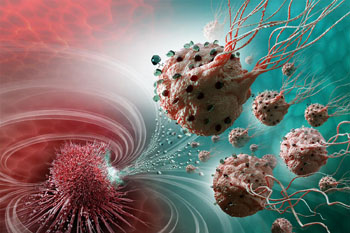Magnetically Guided Bacteria Transport Drug-Loaded Liposomes to Hypoxic Tumors
By LabMedica International staff writers
Posted on 24 Aug 2016
A novel transport system for toxic chemotherapeutic drugs is based on a species of bacteria that can be magnetically guided to a tumor where it releases drug-loaded liposomes into the tumor's hypoxic center.Posted on 24 Aug 2016
Investigators at Polytechnique Montréal (Canada) described using Magnetococcus marinus strain MC-1 as the foundation for a novel drug delivery system.

Image: Nanorobotic agents composed of more than 100 million flagellated bacteria - and therefore self-propelled - and loaded with drugs that moved by taking the most direct path between the drug\'s injection point and the area of the body to cure (Photo courtesy of the Montréal Nanorobotics Laboratory, Polytechnique Montréal).
Magnetococcus marinus is a species of Alphaproteobacteria that has the peculiar ability to form a structure called a magnetosome, a membrane encased single-magnetic-domain mineral crystals formed by biomineralization, which allows the cells to orientate along the Earth’s geomagnetic field. In their natural environment, MC-1 cells, each containing a chain of magnetic iron-oxide nanocrystals, tend to swim along local magnetic field lines and towards low oxygen concentrations based on a two-state aerotactic sensing system.
The investigators took advantage of this natural tendency of MC-1 cells by using it to transport liposomes that had been loaded with an anticancer drug. Approximately 70 drug-loaded nanoliposomes were attached to each MC-1 cell, which were guided by a computer-controlled external magnetic field.
In a proof-of-principle study published in the August 15, 2016, online edition of the journal Nature Nanotechnology the bacteria were injected near the tumor in severe combined immunodeficient beige mice and magnetically guided. Results indicated that up to 55% of MC-1 cells penetrated into hypoxic regions of HCT116 colorectal xenografts.
"These legions of nanorobotic agents were actually composed of more than 100 million flagellated bacteria - and therefore self-propelled - and loaded with drugs that moved by taking the most direct path between the drug's injection point and the area of the body to cure," said senior author Dr. Sylvain Martel, professor of medical nanorobotics at Polytechnique Montréal. "The drug's propelling force was enough to travel efficiently and enter deep inside the tumors. This innovative use of nanotransporters will have an impact not only on creating more advanced engineering concepts and original intervention methods, but it also throws the door wide open to the synthesis of new vehicles for therapeutic, imaging and diagnostic agents. Chemotherapy, which is so toxic for the entire human body, could make use of these natural nanorobots to move drugs directly to the targeted area, eliminating the harmful side effects while also boosting its therapeutic effectiveness."
Related Links:
Investigators at Polytechnique Montréal













